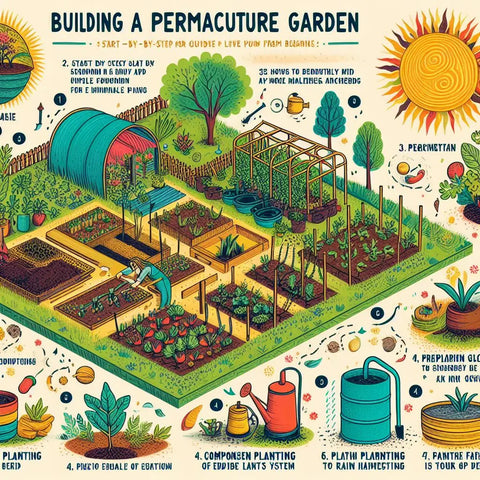Starting Your Sustainable Living Journey with a Permaculture Garden
Building a Permaculture Garden for Beginners
If you're a beginner who is entering the field of sustainable living and want to start growing your crops, starting with your permaculture garden as an initial step would be a good place to begin. Permaculture, which is often described as "permanent agriculture," is a design system that stresses the thoughtful creation of human and natural surroundings by utilizing the working principles of interconnected natural ecosystems. Through practicing permaculture, you can get one that is not too busy and highly productive but requires as little maintenance as possible and produces large yields from the limited input. In this article, we'll teach you the basics of building a permaculture garden, including how to choose a site, how to plant different varieties, and some advanced topics.

Site Selection and Design:
The starting point in designing a people-engineered side view should be the choice of the appropriate site. Of course, you’ll be looking for a sun-bathed space with sufficient drainage and a convenient water supply. Check the site regularly, day-by-day and year-round, to be able to assess the microclimates, wind direction, and appropriate sun positioning. Always, when you are planning a permaculture garden, take into account that using the zone design technique will allow you easy access to different areas as often as you need them. Using the fruit of experience, plant the same types of herbs and veggies that you use daily near your home. Dispose of the larger trees to the distances.
Building healthy soil:
Healthy soil is the starting point when you get involved in a permaculture garden system. To kick off the process, carry out a soil test to establish if the soil is acidic or alkaline, as well as the nutrient contents. Enrich or change the soil with well-rotted compost, manure, and other organic matter, if needed, to improve the soil structure and fertility. Use a variety of plants, for instance, nitrogen-fixing plants like legumes, to achieve natural soil enrichment. Organic matter such as bark chips and leaves are perfect ingredients for covering the dirt; these will keep the soil moist and reduce competition by discouraging the emergence of weeds.
Companion Planting and Polycultures:
One crucial aspect that is adopted in the permaculture garden for beginners is companion planting and polycultures, where numerous crops are grown together. Some plants could share their beneficial interrelationships, like the "three sisters," and the comers are corn, beans, and squash. Corn forms the tripod that supports pole beans, their ability to neutralize nitrogen in the soil, and the richness of Native Americans in the history of American modern farming. Try grouping plant seedlings and noticing how they compete for light and space.
Water Management:
Water is a priceless asset, and the safeguard of a well-managed garden is the ability to ensure that water resources are properly used. You can also look at the construction of a rainwater harvesting system that will store water for you to use in the garden. Provide a way for water to slow down and redirect by using swales, berms, and other earthworks, which should be an important control tool to increase soil infiltration rate and spoil runoff. Mulching and the installation of drought-tolerant plants are other methods of conserving water.
Getting a permaculture garden for a beginner student is a rewarding voyage that requires some patience, understanding, and a desire to learn from nature. Implementing these fundamentals is going to simplify your way of growing a low-maintenance, long-lasting plant that can give you fresh and healthy foods that last for years.
Conclusion:
Envision now the creation of a permaculture garden for beginners may be challenging work, but with this knowledge and approach, it can be the most fulfilling and joyful friend you will ever have. Through the knowledge of site planning, designing healthy soil, companion planting, and polycultures, you'll have a vibrant and productive garden that works with natural resources and efficiency.
Please note that permaculture is a dynamic process of the accumulation of new skills and knowledge, so don't be shy about trying different approaches, making mistakes, and changing if they don't work. Slowly but surely, your permaculture garden for beginners will grow into a productive oasis, yielding all the fresh and nutritious fruits and vegetables that make your mealtime more fun. At the same time, you are playing a role in forming a future that is better for our world's well-being.
FAQs
A question that is interesting for those who are into permaculture is, when is the best time to start a garden as a beginner in this field?
The best time for beginner home gardeners to begin their permaculture gardens would be in the early spring or mid-fall. That's when the weather tends to be milder, and the weather won't be as extreme and risky. Nevertheless, if you are careful and intentional, you can choose to begin this training scheme at the time that is most suitable for you.
Could anyone offer me some tips on the space needed for a beginner’s permaculture garden?
For those who may start with smaller gardens like a yard or balcony, they can still try a permaculture garden within that space. The most important thing is creating an area that is not only spacious but also inhabited by plants that the space allows. Initiate with something small, and then progress once you get comfortable later on.
Are there any particular tools or instruments I’ll need to design an entry-level permaculture garden?”
If you have special tools, they can be helpful, but even with old, simple tools such as hammers, you could start with the lowest cost. Gardening tools such as spades, rakes, hoes, and pruners are enough to perfectly cater to beginners and permit gardening.





Leave a comment